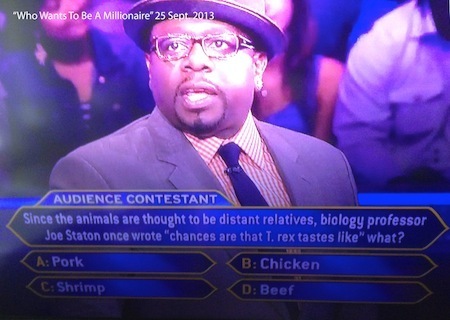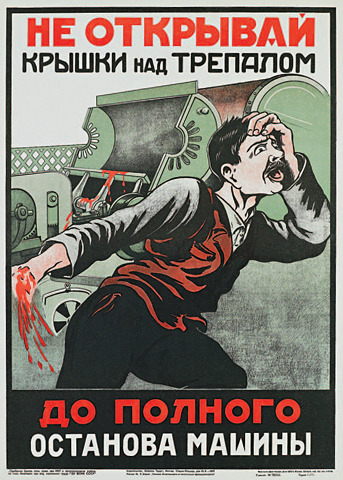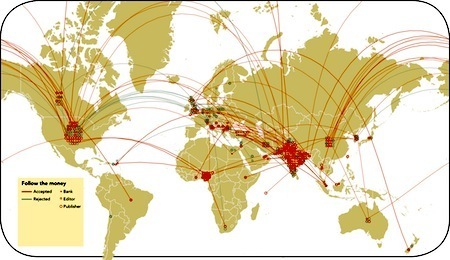Marc Abrahams's Blog, page 458
October 7, 2013
Tastes like chicken for millionaires (with a dinosaur twist)
Joe Staton’s classic article “Tastes Like Chicken” was the subject of a question on the September 25, 2013 edition of the “Who Wants to Be a Millionaire?” TV program:
The question posed to contestants on that program: “Since the animals are thought to be distant relatives, biology professor Joe Staton once wrote ‘chances are that T. rex tastes like’ what?”
Joe Staton is Associate Professor of Biology/Marine Science at the University of South Carolina. His article, written when he was at Harvard University’s Museum of Comparative Zoology, was published in 1998 in the Annals of Improbable Research.
BONUS VIDEO (only vaguely related — thanks to Jennifer Oullette and Io9 for bringing it to our attention):

Introducing a concept: Hortiporn
What is Hortipornography? We can do no better than consult the word’s coiners – Dr. Paul Hewer, now Senior Lecturer in Marketing at Strathclyde University, Scotland, and Professor Douglas Brownlie, at the University of Stirling, Scotland, who originated the term in their paper ‘Constructing Hortiporn: On the Aesthetics of Stylized Exteriors’ (in: Advances in Consumer Research, Vol 33, pp. 36-42)
“
Walk through many large bookstores to the section now known as ‘lifestyles’ and you will find crowded shelves of glossy gardening books competing to attract and hold your attention and spending power. Open some of those books and you will immediately be struck by their meritorious production values: glamorous photographic images of enchantingly aestheticized spaces not only decorate the text, they punctuate it, revealing the carefully deployed hands of designer calculation and the expensive grammar of fine art photography. In this sense such texts are purposefully landscaped, i.e. designed, moulded and assembled so as to provide a very particular vista, deeply enmeshed within dominant regimes of meaning. We understand this as one moment in the historical process of the ‘aesthetic fetishising’, the hortipornography of gardens and gardening.”
By way of example, the authors cite the work of award-winning garden designer and TV presenter Joe Swift, whose oeuvre is analysed from several different angles in the paper (Foucault & etc).
NOTE: Sadly, the essay doesn’t include any hortipornographic photography or drawings of any kind, so Improbable encourages readers who might be interested in hortipornography (purely from an academic viewpoint of course) to browse Mr. Swift’s website (from which the luscious photo above is taken).
BONUSes : The same research team have also produced a considerable body of work on ‘Gastroporn’, particularly focussing on TV celebrity chef Nigella Lawson, e.g. “(Re)covering” the spectacular domestic : culinary cultures, the feminine mundane and brand Nigella (in: Advertising & Society Review Vol 12, No. 2) “… the staged televisual spectacle of Nigella dipping her forefinger teasingly into a warm nest of chocolate will clearly remind you of the nexus of food, sex and femininity”.
Here are some authentic video clips showing Nigella in action . . .
. . . and, a probably not-so-authentic video clip

October 6, 2013
It’s a bit livelier than other ceremonies… [video]
Someone in the audience took this 18-second-long video — a view from the balcony at the start of the 2013 Ig Nobel Prize ceremony:

October 5, 2013
Trussed by too-easily trusting data?
Jean-Claude Bradley writes in the Useful Chemistry blog:
I’m not sure what my students expected before taking my Chemical Information Retrieval class this fall. My guess is that most just wanted to learn how to use databases to quickly find “facts”. From what I can gather much of their education has consisted of teachers giving them “facts” to memorize and telling them which sources to trust…. If I did my job correctly they should have learned that no sources should be trusted implicitly.
I have previously discussed how trust should have no part in science. It is probably one of the most insidious factors infesting the scientific process as we currently use it. To demonstrate this, I had students find 5 different sources for properties of chemicals of their choice. Some of the results demonstrate how difficult it can be to obtain measurements with confidence….
(Thanks to David Weinberger and Mark Dionne for bringing this to our attention.)

Quasi-ancient tributes to DNA
Here’s quasi-ancient, grainy, degraded video from the 1995 Ig Nobel Prize ceremony. The theme that year was DNA. Behold tributes to DNA, first from young Kate Eppers; then from Nobel Laureates Rich Roberts, Dudley Herschbach, Joseph Murray, Sheldon Glashow, and William Lipscomb reading a poem by Stanley Eigen (“DNA and Green Eggs and Ham”)…
BONUS: Accounts of that ceremony, from Scientific American, from the American Physical Society (APS), from 1995 Ig Nobel Nutrition Prize winner John Martinez, from New Scientist.
BONUS: Shelly Glashow’s subsequent letter about the DNA Cologne sample that he received at the ceremony
BONUS: A leap into what was then the far future: The Guardian‘s Will Woodward visited the 2004 Ig Nobel Prize Ceremony

Ig Nobel Prizes on PBS NewsHour this Sunday
PBS NewsHour Weekend plans to broadcast a report about the Ig Nobel Prizes this Sunday, October 6, as the program’s final segment.
Here’s some extra material that did not make it into NewsHour’s final edit:

October 4, 2013
Safety first! The no-handy man.
Today’s historical industrial safety poster is from Russia, part of a collection amassed by an admirer of this distinctive form of art:

In Lamentably-Successful Search of Rotten, Scammy Journals
Reader (when reading a study) and writer (when submitting a study for publication) beware — if the journal publishing (or offering to publish) that study is not known to you. Dan Vergano explains, in this National Geographic article:
Fake Cancer Study Spotlights Bogus Science Journals
A cancer drug discovered in a humble lichen, and ready for testing in patients, might sound too good to be true. That’s because it is. But more than a hundred lower-tier scientific journals accepted a fake, error-ridden cancer study for publication in a spoof organized by Science magazine. The fake study points to a “Wild West” of pay-to-publish outlets feeding off lower tiers of the scientific enterprise by publishing studies without any appreciable scrutiny…
John Bohannon is the person behind this effort to test for rotten, scammy journals. His article begins:
“Who’s Afraid of Peer Review?” John Bohannon, Science, vol. 342, no. 6154, October 4, 2013, pp. 60-65.
“On 4 July, good news arrived in the inbox of Ocorrafoo Cobange, a biologist at the Wassee Institute of Medicine in Asmara. It was the official letter of acceptance for a paper he had submitted 2 months earlier to the Journal of Natural Pharmaceuticals, describing the anticancer properties of a chemical that Cobange had extracted from a lichen.
“In fact, it should have been promptly rejected. Any reviewer with more than a high-school knowledge of chemistry and the ability to understand a basic data plot should have spotted the paper’s short-comings immediately. Its experiments are so hopelessly flawed that the results are meaningless.
“I know because I wrote the paper. Ocorrafoo Cobange does not exist, nor does the Wassee Institute of Medicine. Over the past 10 months, I have submitted 304 versions of the wonder drug paper to open-access journals. More than half of the journals accepted the paper, failing to notice its fatal flaws. Beyond that headline result, the data from this sting operation reveal the contours of an emerging Wild West in academic publishing….”
Bohannon graphically illustrates of how the money flows in this curious backwater of the publishing industry, commenting that “The location of a journal’s publisher, editor, and bank account are often continents apart”:
BONUS. What does it all mean? Perhaps this:
Bohannon’s experiment demonstration two related principles:
The goodness of any system that depends on people depends on those people really trying to be good.
The mere functioning of the system is not restricted by or to reality.
(This week, we also see these principles being demonstrated on a larger scale in the US government.)

Tattoo copyright conundra
 Intellectual property law in many countries (e.g. US and UK) asserts that when an artist creates an original artwork, he or she automatically owns the copyright. But what if you happen to be, say, a tattoo artist? What’s the legal position when the tattoo – which is now permanently attached to the person who acted as its artistic substrate – walks out of your studio and is displayed to the wider world, without your permission? Have you the artist ‘agreed’, by default, to its public exhibition – in other words to licence its re-use? We now enter the enigmatic world of ‘Implied Licences’. (An example of an ‘Implied Licence’ is the so-called ‘Browse-Wrap Agreement’ – the kind that says something along the lines of : “By browsing this website you agree to be bound by the following terms and conditions of use . . .”)
Intellectual property law in many countries (e.g. US and UK) asserts that when an artist creates an original artwork, he or she automatically owns the copyright. But what if you happen to be, say, a tattoo artist? What’s the legal position when the tattoo – which is now permanently attached to the person who acted as its artistic substrate – walks out of your studio and is displayed to the wider world, without your permission? Have you the artist ‘agreed’, by default, to its public exhibition – in other words to licence its re-use? We now enter the enigmatic world of ‘Implied Licences’. (An example of an ‘Implied Licence’ is the so-called ‘Browse-Wrap Agreement’ – the kind that says something along the lines of : “By browsing this website you agree to be bound by the following terms and conditions of use . . .”)
The implications for tattooists are discussed in a paper for the current issue (Vol. 31, Issue 2) of The Cardozo Arts & Entertainment Law Journal where author Craig P. Bloom outlines the legal position in ‘Hangover Effect: May I See Your Tattoo, Please?’
“Hanging over every tattooed individual is the potential for a copyright infringement lawsuit. Yet, an implied license remains a powerful shield that protects a tattoo holder from such actions.“
For some experts, explains the author, take the position that :
“By virtue of the unique nature of a tattoo, which is permanently affixed to and displayed on a person’s skin, a tattoo holder has an implied license to use, display and exploit the tattoo.”
Others are not so convinced : e.g. copyright authority David Nimmer (author of Copyright in the Dead Sea Scrolls: Originality and Authorship, (Hous. L. Rev. 1, 2001) who posits (in Whitmill v. Warner Bros, 2011)
“… human flesh cannot serve as the ‘medium of expression’ that Congress intended to embody legally protectible authorship.”
Returning to Bloom, the author concludes that the contentious issue of tattoo copyright remains to this date, (in the US at least) quite ill-defined :
“… the issue of whether tattoos can be copyrighted remains unsettled and novel in the sense that no judicial decision has been rendered on the merits.”
Also see : Tattoo disruption avoidance and Body: Search for Deviants and Professorial Product Placement.
Bonus : (old) joke : Seen on tattooist’s studio window “TATTOOS : WHILE YOU WAIT”
Credit : The retouched public domain picture above is courtesy of the FDA ‘Think Before You Ink’

October 3, 2013
Whale info “supplied by a sub-sub-librarian”
Studyworld Study Notes muses, sort of, on a passage from Herman Melville’s novel Moby Dick:
Melville’s experiments with form begin with the two short sections that appear before the start of the actual narrative. The first, “Etymology,” gives the words for “whale” in various languages, from Greek to “Erromangoan,” and credits this information to “a late consumptive usher to a grammar school”: one of Melville’s first darkly comic lost souls. The second section, “Extracts,” is a collection of short quotations from books ranging from the Bible to Hawthorne to Milton to sea-shanties, all referring to whales. These are said to be “supplied by a sub-sub-librarian,” eulogized by the author as “a mere painstaking burrower and grub-worm of a poor devil of a Sub-Sub.” Melville here prepares us for the stylistic weirdness of the rest of the novel, and begins to present the notion that the whale is obsessively defined by many, but understood by few.
Here’s the passage, read aloud by Stewart Wills in multi-language glory:

Marc Abrahams's Blog
- Marc Abrahams's profile
- 14 followers






